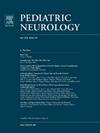癫痫患儿解剖电临床表型及DYNC1H1突变
IF 3.2
3区 医学
Q2 CLINICAL NEUROLOGY
引用次数: 0
摘要
背景:编码细胞质动力蛋白1重链1的DYNC1H1的致病变异与广泛的神经综合征有关。方法:我们分析了4例该基因致病性变异患者的临床资料、视频脑电图、神经影像学特征和遗传结果。结果:不同的神经影像学和神经生理学标志的全面描述,可以帮助识别这些条件提供。结论:已经确定了两种表型:1)3例患者表现为发育性和癫痫性脑病,伴局灶性发作和癫痫性痉挛,并伴有无脑畸形谱内皮层发育的复杂畸形;2)第4例患者表现为发育性和癫痫性脑病,伴睡眠尖波激活,伴双额多小回畸形。值得注意的是,这是第一例报道的多小回症和癫痫性脑病在睡眠中出现尖波激活,并有潜在遗传疾病的证据。本文章由计算机程序翻译,如有差异,请以英文原文为准。
Anatomo-Electro-Clinical Phenotypes in Children With Epilepsy and DYNC1H1 Mutations
Background
Pathogenic variants in DYNC1H1, which encodes the cytoplasmic dynein 1 heavy chain 1, have been linked to a wide range of neurological syndromes.
Methods
We analyzed clinical data, video-electroencephalography, neuroimaging features, and genetic results in four patients with pathogenic variants in this gene.
Results
A comprehensive description of distinct neuroimaging and neurophysiological hallmarks that can aid in the recognition of these conditions is provided.
Conclusions
Two phenotypes have been identified: 1) three patients presented with developmental and epileptic encephalopathy with focal seizures and epileptic spasms, along with a complex malformation of cortical development within the lissencephaly spectrum, and 2) the fourth patient exhibited developmental and epileptic encephalopathy with spike-and-wave activation in sleep along with bifrontal polymicrogyria. Notably, this is the first reported case of polymicrogyria and epileptic encephalopathy with spike-and-wave activation in sleep with evidence of an underlying genetic disorder.
求助全文
通过发布文献求助,成功后即可免费获取论文全文。
去求助
来源期刊

Pediatric neurology
医学-临床神经学
CiteScore
4.80
自引率
2.60%
发文量
176
审稿时长
78 days
期刊介绍:
Pediatric Neurology publishes timely peer-reviewed clinical and research articles covering all aspects of the developing nervous system.
Pediatric Neurology features up-to-the-minute publication of the latest advances in the diagnosis, management, and treatment of pediatric neurologic disorders. The journal''s editor, E. Steve Roach, in conjunction with the team of Associate Editors, heads an internationally recognized editorial board, ensuring the most authoritative and extensive coverage of the field. Among the topics covered are: epilepsy, mitochondrial diseases, congenital malformations, chromosomopathies, peripheral neuropathies, perinatal and childhood stroke, cerebral palsy, as well as other diseases affecting the developing nervous system.
 求助内容:
求助内容: 应助结果提醒方式:
应助结果提醒方式:


